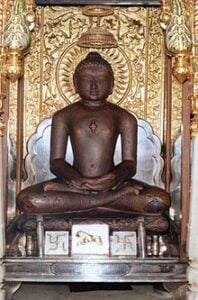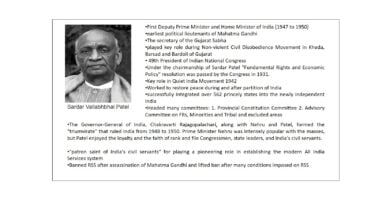Vardhmana Mahavir Jayanti
Context:
The President of India, Shri Ram Nath Kovind in his message on the eve of Mahavir Jayanti
About Jainism:
- According to jain text tradition there were 24 Thirthankaras (literally ford maker across the stream of existence), the being Rishabhadeva/Adinatha and last being Mahavira
- The Vishnu Purana and the Bhaga vat Purana describe Rishabha as an incarnation of Narayana.
- The name of two Jain Tirthankaras-Rishabha and Arishtanemi-are found inthe Rig Veda.
- We have historical proof of only the last two-Parshwanatha (23rd) and Mahavira (24th).
- Parshwanatha was a prince of Benaras who abandoned the throne and led the life of a hermit and died at Sammte – Shikar/ Parshwanath (Parasanath)Hill, Giridih,.Jharklhand. His four main teachings ( Chaturthi) were
- 1.Abimsa (non-injury )
- 2.Satya (non-lying)
- 3. Asteya (non-stealing)
- 4. Aparigraha (non-possession).
- Mahavira adopted all these four teachings and added one more that is Brahmacharya (Chastity) to it.
Mahavira’s Life
- Mahavira was born in 540 BC in a village Kundgrama near Vaishali in Bihar.
- His father Siddhartha was the head of the jnathrika Kshttriya clan under Vajji of Vaishali and his mother Trishala was the sister of Chetaka, the king of Vaishali. Mahavira was also related to Bimbisara, the ruler of Magadha, who had married Chellana, the daughter of Chetaka.
- Mahavira was married to Yashoda (daughter of Sam arvira king) and a produced a daughter Anonja Priyadarshini whose husband Jamali, became the first disciple of Mahavira.
- At the age of 30, after the death of his father, he renounced his family, became anascetic and proceeded insearch of truth. He was accompained by Makkhali Gosala, but later due to some differences Gosala left him and founded Ajivika sect.
- At the age of 42, under a sal tree at famb jambhikagrama on the bank of river Rijupalika, Mahavira attained Kaivalya (supreme knowledge).
- From now onwards he was called Kevalin (perfect learned), Jina or ]itendriya (one who conquered his senses), Nrigrantha (free from all bonds) ,Arhant (blessed one) and Mahavira (the brave) and his followers were named jain.
- He delivered his first sermon at Pava to his 11 disciples (known as 11 Gandharas/ Gandharvas). Later, he f ounded a Jain Sangha (Jain commune) at Pava.
- At the Age of 72 in 468BC, he passed away at Pavapuri near Biharsharif in Bihar. Sudharma only one of 11 Ganadharas who survived after the death of Mahavira.
24 Tirthankaras
| Name | Symbol |
| 1. Rishabha 2. Ajitnath 3. Sambharnath 4. Abhiaandam 5. Sumatinath 6. Padmaprabhu 7. Suparswanath 8. Chandraji ·Prabhu 9. Suvidhinath lO. Shitalnath 11. Shreganath 12. Vasupujya 13. Vimalnath 14. Anantnath 15. Dharmanath 16. Shantinath 17. Kuntunath 18. Arnath 19. Mallinath 20. Muniswasth 21. Neminath 22. Arishtanemi 23. Parshwanath 24. Mahavira | Bull Elephant Horse Monkey Curlew Red Lotus Swastik Moon Crocodile Srivatsa Rhinoceros Buffalo Boar Falcon Vajra Deer He-Goat Fish Waterpot Tortoise Blue Lotus Conch shell Serpent Lion |
Doctrines of Jainism
Triratna i.e. Three Gems of Jainism
The aim of existence is to attain through the triratna of
- samyak Shradha/ Viswas (Right faith) : it is the belief in Thirathankaras.
- samyak jnan (Right knowledge) : It is the knowledge of the Jain ‘ creed.
- Samyak Karma/ Acharana (Right action/conduct) : It is the practice of the 5 vows of Jainism
Pancha Maha varatas i.e. Five Vows of Jainism
Five vows of Jainism are:
1. Ahimsa (non—injury)
2. Satya (non-lying)
3. Asreya (none—stealing)
4. Aparigraha (non—possession)
5. Brahmacliarya (chastity).
The first four vows were laid down by Parshwanath. The fifth One was added by Mahavira
Types of Knowledge
There are 5 types of knowledge:
1. Mati jnana — Perception through activity of sense organs, including the mind
2. Shruta jnana — Knowledge revealed by scriptures
3. Avadhi jnana — Clairvoyant perception
4. Manahparyaya jnana — Telepathic knowledge
5. Keval jnana — Temporal knowledge or Omniscience.
Syadvada i.e. The Theory of May Be/Perhaps:
All our judgments are necessarily relative, conditional and limited. According to SyadavadaSeven modes of prediction (Saptabhangi Nayavad) are possible. Absolute affirmation and absolute negation both are wrong. All judgments are conditional. Syadvada is also known as Anekantvada i.e. the theory of plurality or multi—sidedness.
The Principles of Jainism as Preached by Mahavira:
1. Rejected the authority of the Vedas and Vedic rituals
2. Did not believe in the existence of God.
3. Believed in Karma and the transmigration of soul
4. Laid great emphasis on equality.
| Jain Council Year
| Year
| Venue
| Chairman
| Patron
| Result |
1st | 300 BC | Patliputra | Sthulabhadra
| Chandragupta Maurya | ompilation of 12 Angas. |
2nd | 512 AD | Vallabhi | Devardhi Kshmasramana
| _______ | Final compilation of12 Angas and 12 Upangas.
|
Jain Literature
The sacred literature of the Svetambaras is written in a type of Prakrit called Ardhamagadhi Prakrit, and may be classified as follows:
1. 12 Angas
2. 12 Upangas
3. 10 Parikarnas
4. 6 Chhedasutra
5. 4 Mulasutras
6. Sutra Granthas
Note: Purvas/ Parvas it is part of 12 Angas and oldest text of Mahavira perching’s
Besides this, the important Jain texts are:
1. Kalpasutra (in Sanskrit)
2. Bhadrabahu Charita
3. Parishishta Parvan (an appendix of Trishashtishalaka Purush) – Hemchandra
Sects of Jainism
In 298 BC, there was a serious famine in Magadha (South Bihar) leading to a great exodus of many Jain monks to the Deccan and South India (Shravanbelgola) along with Bhadrabahu and Chandragupta Maurya LImndmgupm. They returned back after 12 years. The leader of the group, which stayed back at Magadha was Sthulabhadra. When the Jains (Bhadrabahu and Others) returned from South India, they held that complete nudity be an essential part of the teachings of Mahavira, while the monks in Magadha began to put on white clothes. Thus arose the two sects Shvetambaras (white clad) and Digambams (sky-clad).
1. Shvetambams (i.e. those who put on white robes) – Sthulabhadra
2. Digambaras (i.e. those who were stark naked) – Bhadrabahu
Examples of Jain Architecture
1. Gumphas i.e. Caves eg. Hathigumpha, Baghagumpha etc., Udaigiri and Khandagiri (Orissa) – Kharvela
2. Dilwara temples e.g. Vimalavasahi temple, Tejapala temple – Mount Abu (Rajasthan)
3. Temples – Giranar and Palitana (Gujarat)
4. Temples e.g. Pavapuri temple, Rajagriha temple – Bihar
5. Statue of Gomteshwara/ Bahubali – Shravanbelgola (Karnataka).
Royal Patrons
1. North India: · Nandas; Bimbisar, Ajatshatru and Udayin (Haryank); Chandragupta Maurya, Bindusara and Samprati (Mauryan) – Magadha · Pradyota (Avanti) · Udayan (Sindhu-Sauvira) · Kharavela (Kalinga).
2. South India :· Ganga Dynasty · Kadamb Dynasty · Amoghavasrha (Rashtrakuta Dynasty) Siddharaj Jai Jingh and Kumarpala (Chaulukya / Solanki ) — the last great Patron of Jainism
Discover more from Simplified UPSC
Subscribe to get the latest posts sent to your email.


